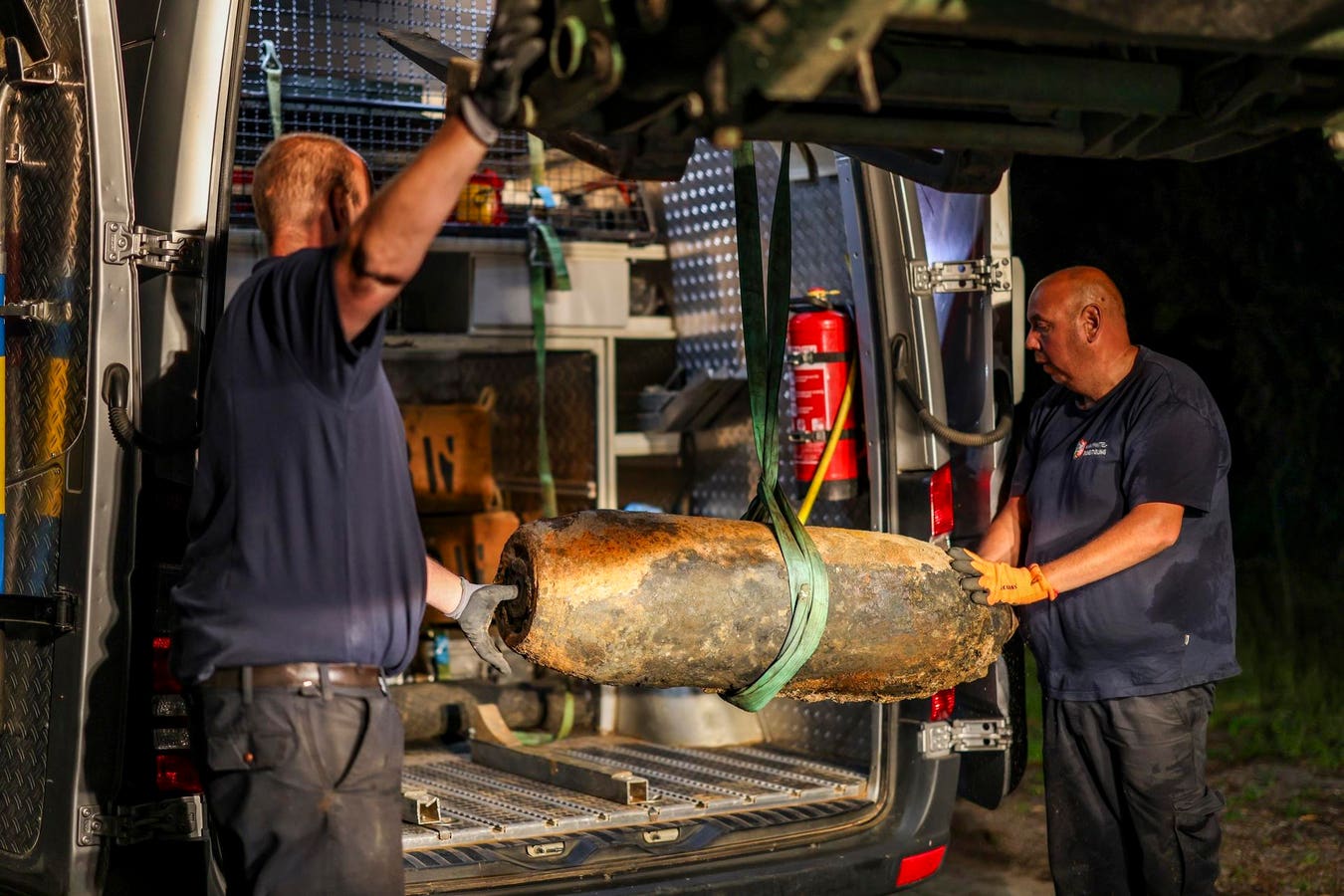June 20, 2024, North Rhine-Westphalia, Cologne: A defused WWII bomb is loaded onto a transport vehicle. Photo: Christoph Reichwein/dpa (Photo by Christoph Reichwein/picture alliance via Getty Images)
dpa/picture alliance via Getty Images
Last month, an 1,100-pound unexploded bomb from WWII, believed to be of American origin, was uncovered near Cologne, Germany, where a construction crew had been digging. Some 3,000 people were evacuated from the area while the bomb was carefully extricated. Earlier last year, similar bombs near Cologne were discovered and defused.
This kind of scenario may prove unimaginable for Americans. What would happen if, say, one of those blockbusters were uncovered in New York City while excavating the support basement for a new building? That, of course, couldn’t happen because during WWII the U.S. wasn’t bombed, but Germany was, extensively.
Poster warning German citizens of the danger of finding unexploded WWII ordnance.
Wolfgang Schutt
Truth be told, the bombs discovered near Cologne are not uncommon. Surprisingly, around 2,000 tons – yes tons – of unexploded ordnance is found, and detonated, annually in Germany.
A while back, I visited the country to imbed for a few days with the brave “hurt locker” German police as they hunted for these things. Part of our experience was out in the field with metal detectors, the other visiting remote bunkers where many of the dangerous munitions are transported, and kept, until detonation. Housed in the bunkers is ordnance of all types – mortars, artillery shells, grenades, aerial bombs, mines – and from countries including Russia, the U.S. and Great Britain.
Peter Ewler, a bomb disposal expert, greeted us at his bunker near the Oder River at the Polish/German border. Once inside, he asked me to pick an artillery shell out of a metal-wire bin, but first to put on gloves. “We must have some rules,” he grinned in a madman kind of way.
Forbes writer Jim Clash holds an unexploded WWII shell in a secluded German bunker facility near the Oder River.
Wolfgang Schutt
I remember the shell I grabbed was medium-sized and heavily-rusted. It scared the hell out of me just holding it. It scared my photographer, a German named Wolfgang Schutt, even more, as he worried that I might drop it.
After our bunker visit, we headed into the field, and found bombs with detonators attached, and some without. The former aren’t stable enough to transport to a bunker, and, as such, must be destroyed on the spot.
German police detonate unexploded WWII ordnance as Forbes writer Jim Clash looks on.
Wolfgang Schutt
One uncooperative scoundrel we found that did have its detonator required us to dig a five-foot hole in the ground, attach an electrical wire to it, carefully place the device at the bottom of the hole, then pile loose dirt on top.
After our crew backed up a few hundred yards, the police officer in charge pushed a button sending an electrical charge to the device. A huge explosion ensued, sending dirt, smoke and shrapnel more than 100 feet into the air. The deafening crack of the explosion arrived a second or two later.
A big misconception: Over time, old ordnance loses potency. After all, the stuff has been buried for what, seven decades, so what’s the big deal?
Often old reconnaissance photos taken by American and British pilots are used by Germany to discover areas with large unexploded WWII bombs.
Wolfgang Schutt
According to a recent study by Royal Society Open Science, the bomb’s casing material deteriorates, but not the active explosives inside like Amatol and TNT, meaning the core explosives are as potent as when they were manufactured. And, because the casing material deteriorates, the core is exposed to outside elements like snow and rain, making the ordnance even more unstable.
Forbes writer Jim Clash surveys a crater created by detonation of unexploded WWII ordnance by German police.
Wolfgang Schutt
Bottomline, Germany is still at war, but this time with itself. And it may be losing. As explained earlier, the longer the explosive chemicals remain in the ground, the more unstable they become. Like Ernest Hemingway wrote in one of his short stories: “William Campbell was in a pursuit race with a burlesque show.” Except this time William Campbell is Germany, and the burlesque show is unexploded ordnance.
